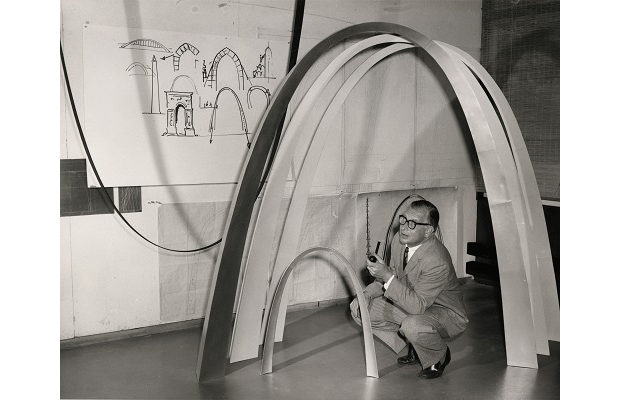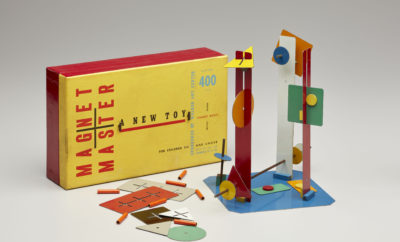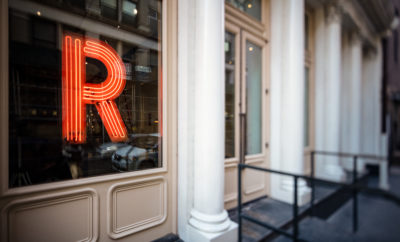
Exhibition
St. Louis Honors its Iconic Arch with a Closer Look

TO THOSE WHO LIVE NEAR IT, St. Louis’s Gateway Arch serves as the backdrop to baseball games, a highlight in the riverside skyline, and a welcoming beacon to those traveling west. Despite the public’s initial resistance to its abstract parabolic shape, the steel-clad national landmark by Finnish-born Eero Saarinen is celebrated as both a symbol of civic pride and prosperity and as a monumental achievement when talking about mid-century modernism in America and, more specifically, in St. Louis.
With the Arch turning fifty this past October, David Conradsen, Grace L. Brumbaugh and Richard E. Brumbaugh Associate Curator of Decorative Arts and Design at the Saint Louis Art Museum, found the timing ideal to host an exhibition showcasing the city’s surprisingly robust wealth of and contributions to modernist design. “The museum’s mission is to celebrate local artistic achievements of note,” Conradsen says—“this story has been told in L.A. and New York, but ours hadn’t been told yet.”
Starting in 1935, when the plans for a St. Louis national monument began, and spanning the thirty years to the completion of the Arch, St. Louis Modern features 150-plus objects made by local artists and architects, or items procured, collected, and sold throughout the region during the period. Along with research assistant Genevieve Cortinovis, Conradsen assessed the museum’s permanent and on-loan collection before posting want ads, conducting extensive and obscure Google searches, and following lead after lead from someone who knew someone who knew someone to find just the right pieces to tell the story—and fill the seven thousand-square-foot gallery. What they’ve gathered is a fascinating array of kitchenwares, furniture, sculpture, stained glass, paintings, and a panoply of other objects. “One of the show’s goals is to discover amazing stories, collectors, patrons, architects, and history,” Conradsen says. “I love finding those things that not everyone knows about and spreading the word.”
Modernism’s connections to the region are numerous; not only were ideas coming into St. Louis, they were also originating there and playing an important role in the development of modernism on a broader scale. Charles Eames and Gyo Obata attended Washington University; Missouri-based architect Harris Armstrong hung an Isamu Noguchi Floating Lunar lamp in his office; and Italian-born Harry Bertoia’s metal sculpture adorned the main terminal at Lambert-St. Louis Airport.

Harry Bertoia
Included in the exhibition are a 1954 Chevrolet Corvette manufactured in the city; a Gilbert Rohde end table owned by a local couple who decorated their house primarily from the Herman Miller catalogue; Alvar Aalto chairs purchased in Chicago for a doctor’s office in St. Louis; an Eames storage unit from the museum’s permanent collection; and textile samples from the California-based artist Dorothy Wright Liebes, who had her own installation at the museum in 1940. The show taps into the interests of everyone from Mad Men fans to preservationists and from car buffs to IKEA enthusiasts.
In addition to the modernist objects included in the show, architectural expressions of the age are still to be found around the region. While many of St. Louis’s modernist banks, gas stations, private houses, schools, medical buildings, apartment buildings, department stores, and libraries didn’t make it past the 1990s, others have been recognized and restored, often for different purposes, such as the concrete hyperbolic paraboloid “flying saucer” gas station by Richard Henmi that is now a Chipotle/Starbucks—after years of protests, petitions, and trips to the state capitol. Triumphs like this have proved that there is definitely still a place in the city’s landscape for the mid-century style. “There are buildings that have been lost, but others that have been saved,” Conradsen explains. “We wanted to focus on a moment, open up people’s eyes to the modernist landscape, and make them curious about what is out there.”
This exhibition will provide them with the necessary context, illuminating how St. Louis embraced, developed, and helped perpetuate modern design not only locally, but also nationally and internationally. slam.org












